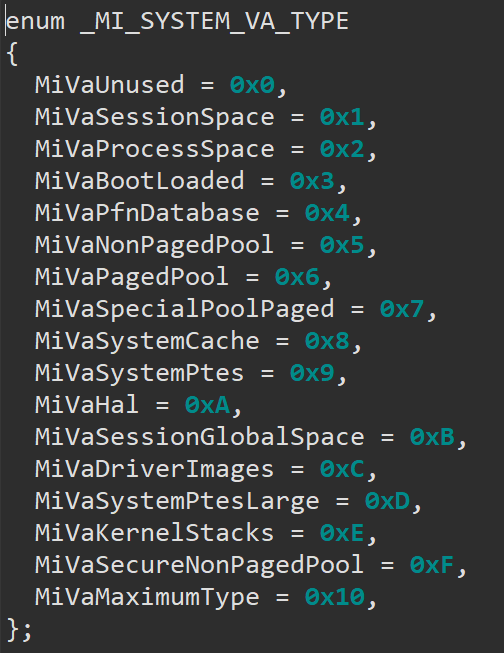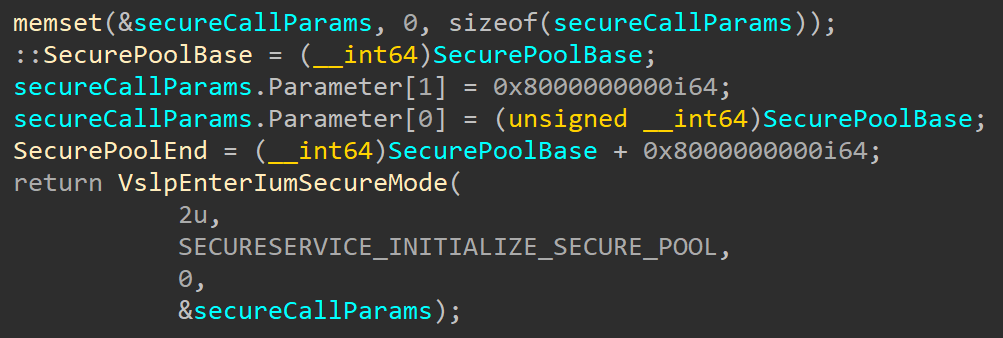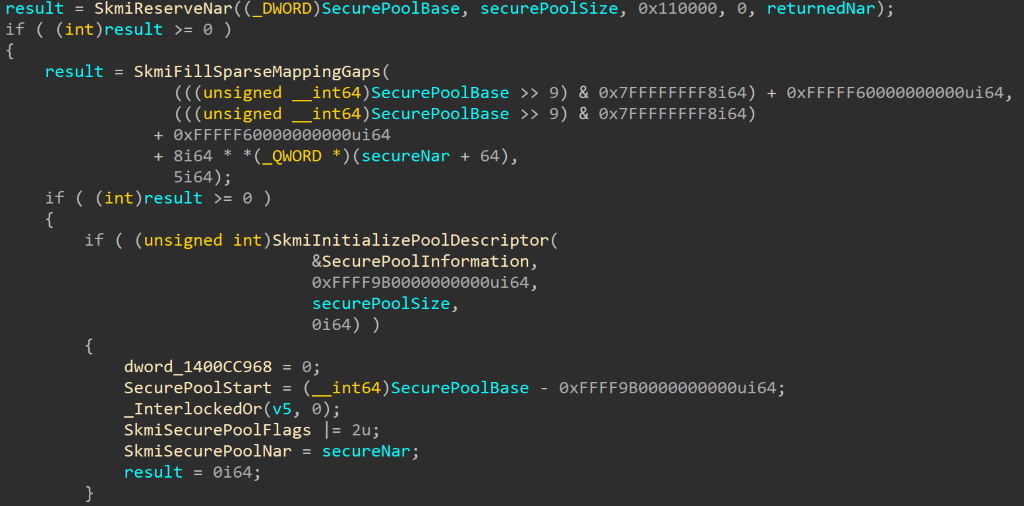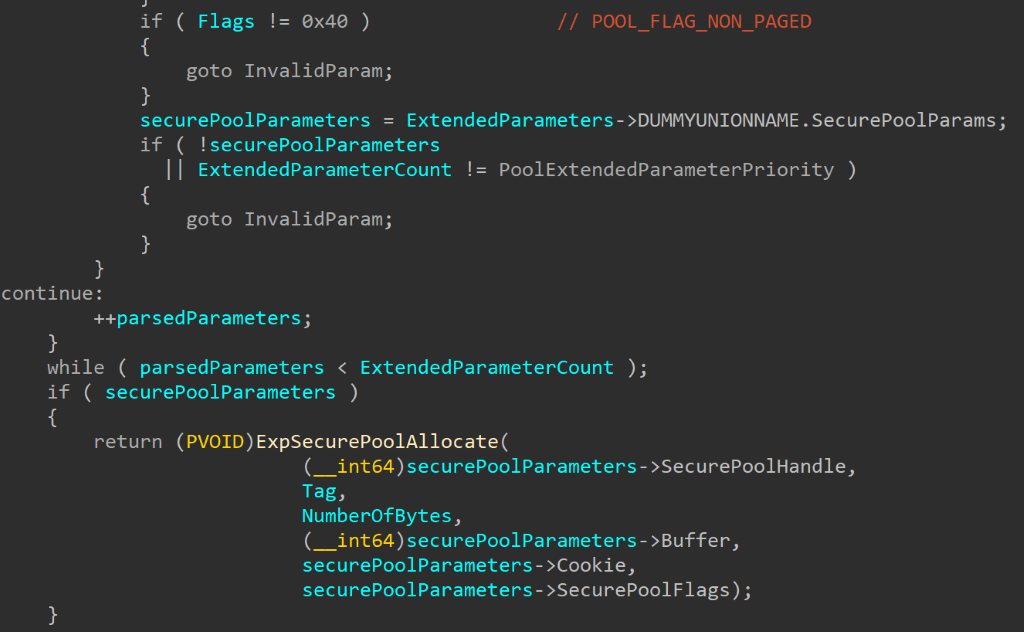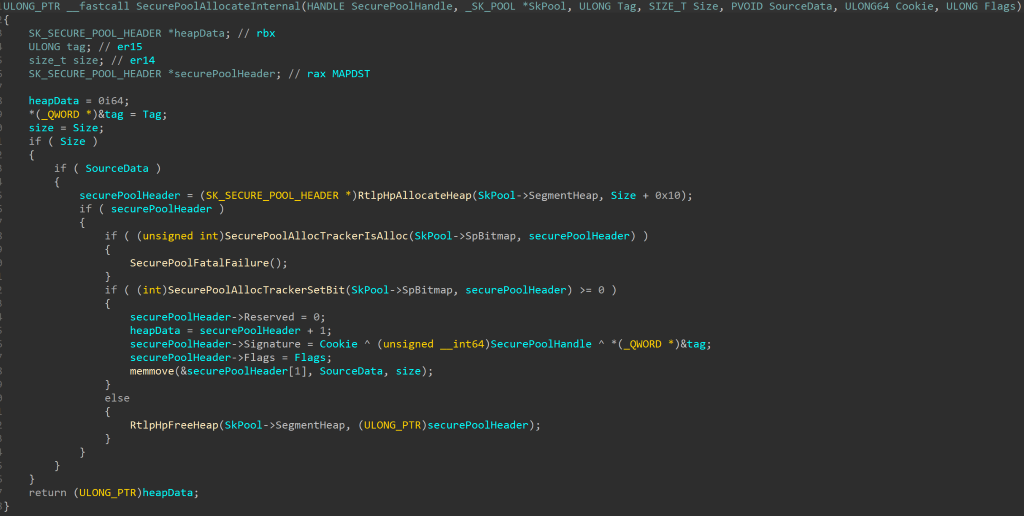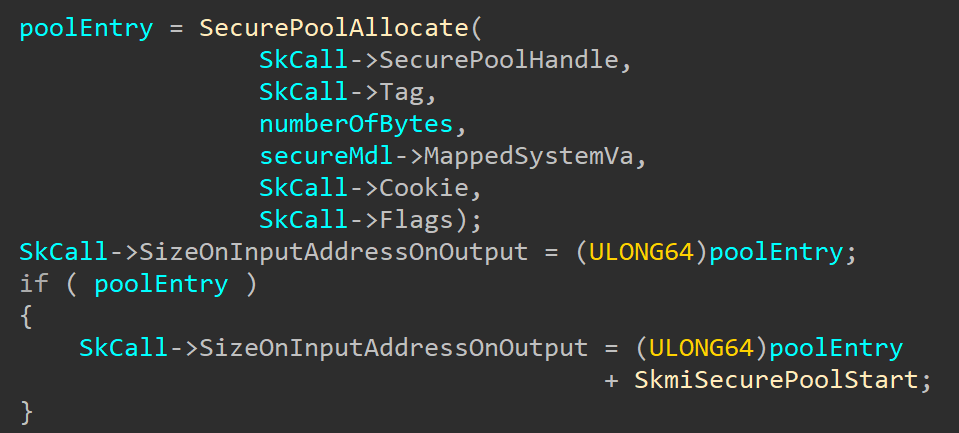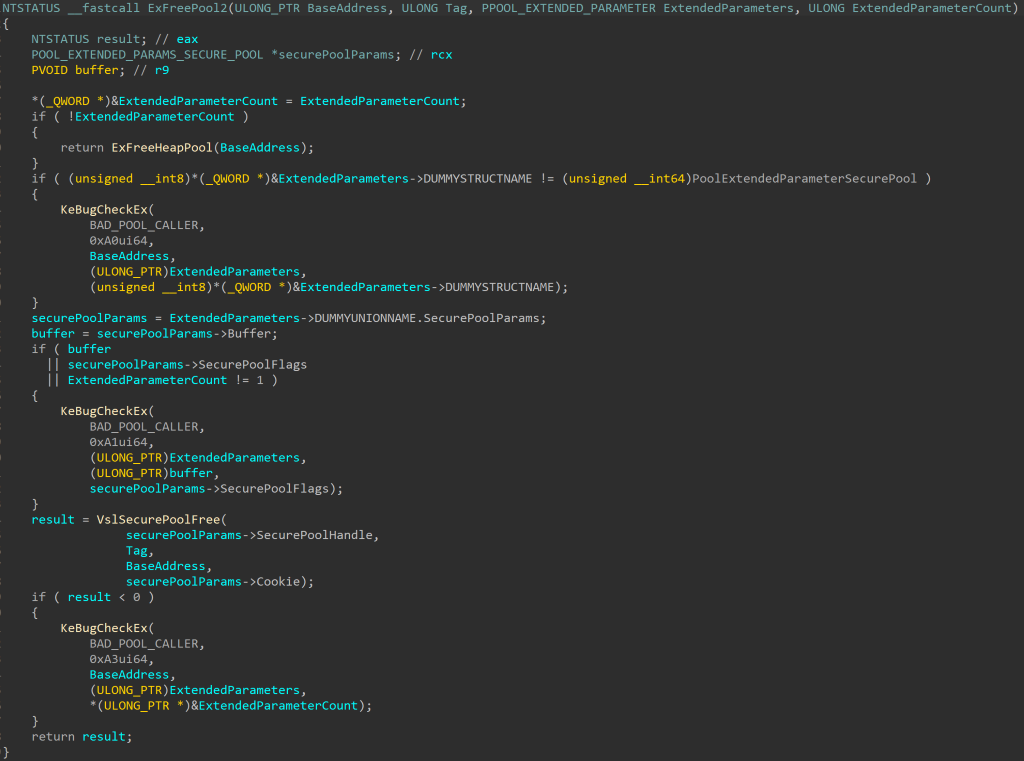Starting with Windows 10 Redstone 5 (Version 1809, Build 17763), a lot has changed in the kernel pool. We won’t talk about most of these changes, that will happen in a 70-something page paper that will be published at some point in the future when we can find enough time and ADHD meds to finish it.
One of the more exciting changes, which is being added in Version 2104 and above, is a new type of pool – the secure pool. In short, the secure pool is a pool managed by Securekernel.exe, which operates in Virtual Trust Level 1 (VTL 1), and that cannot be directly modified by anything running in VTL 0. The idea is to allow drivers to keep sensitive information in a location where it is safe from tampering, even by other drivers. Dave Weston first announced this feature, marketed as Kernel Data Protection (KDP), at his BlueHat Shanghai talk in 2019 and Microsoft recently published a blog post presenting it and some of its internal details.
Note that there are two parts to the full KDP implementation: Static KDP, which refers to protecting read-only data sections in driver images, and Dynamic KDP, which refers to the secure pool, the topic of our blog post, which will talk about how to use this new pool and some implementation details, but will not discuss the general implementation of heaps or any of their components that are not specific to the secure pool.
We’ll also mention three separate design flaw vulnerabilities that were found in the original implementation in Build 20124, which were all fixed in 20161. These were identified and fixed through Microsoft’s great Windows Insider Preview Bug Bounty Program for $20000 USD each.
Initialization
The changes added for this new pool start at boot. In MiInitSystem we can now see a new check for bit 15 in MiFlags, which checks if secure pool is enabled on this machine. Since MI_FLAGS is now in the symbol files, we can see that it corresponds to:
+0x000 StrongPageIdentity : Pos 15, 1 Bit
which is how the kernel knows that Virtualization Based Security (VBS) is enabled on a system with Secondary Level Address Table (SLAT) support. This allows the usage of Extended Page Table Entries (EPTEs) to add an additional, hypervisor-managed, layer of protection around physical memory. This is exactly what the secure pool will be relying on.
If the bit is set, MmInitSystem calls VslInitializeSecurePool, passing in MiState.Vs.SystemVaRegions[MiVaSecureNonPagedPool].BaseAddress:
If we compare the symbol files and look at the MI_SYSTEM_VA_TYPE enum, we’ll in fact see that a new member was added with a value of 15:MiVaSecureNonPagedPool:
VslInitializeSecurePool initializes an internal structure sized 0x68 bytes with parameters for the secure call. This structure contains information used to make the secure call, such as the service code to be invoked and up to 12 parameters to be sent to Securekernel. In this case only 2 parameters are used – the requested size for the secure pool (512 GB) and a pointer to receive its base address:
It also initializes global variables SecurePoolBase and SecurePoolEnd, which will be used to validate secure pool handle (more on that later). Then it calls VslpEnterIumSecureMode to call into SecureKernel, which will initialize the secure pool itself, passing in the secureCallParams structure that contains that requested parameters. Before Alex’s blog went down, he was working on an interesting series of posts on how the VTL 0 <-> VTL 1 communication infrastructure works, and hopefully it will return at some point, so we’ll skip the details here.
Securekernel unpacks the input parameters, finds the right path for the call, and eventually gets us to SkmmInitializeSecurePool. This function calls SecurePoolMgrInitialize, which does a few checks before initializing the pool.
First it validates that the input parameter SecurePoolBase is not zero and that it is aligned to 16 MB. Then it checks that the secure pool was not already initialized by checking if the global variable SecurePoolBaseAddress is empty:
The next check is for the size. If the supplied size is larger than 256 GB, the function ignores the supplied size and sets it to 256 GB. This is explained in the blog post from Microsoft linked earlier, where the secure kernel is shown to use a 256 GB region for the kernel’s 512 GB range. It’s quote curious that this is done by having the caller supply 512 GB as a size, and the secure kernel ignoring the parameter and overriding it with 256.
Once these checks are done SkmmInitializeSecurePool starts initializing the secure pool. It reserves a Normal Address Range (NAR) descriptor for the address range with SkmiReserveNar and then creates an initial pool descriptor and sets global variables SkmiSecurePoolStart and SkmiSecurePoolNar. Notice that the secure pool has a fixed, hard-coded address in 0xFFFF9B0000000000:
Side note: NAR stands for Normal Address Range. It’s a data structure tracking kernel address space, like VADs are used for user-space memory. Windows Internals, 7th Edition, Part 2, has an amazing section on the secure kernel written by Andrea Allevi.
An interesting variable to look at here is SkmiSecurePoolStart, that gets a value of <SecurePoolBaseInKernel> - <SecurePoolBaseInSecureKernel>. Since the normal kernel and secure kernel have separate address spaces, the secure pool will be mapped in different addresses in each (as we’ve seen, it has a fixed address in the secure kernel and an ASLRed address in the normal kernel). This variable will allow SecureKernel to receive secure pool addresses from the normal kernel and translate them to secure kernel addresses, an ability that is necessary since this pool is meant to be used by the normal kernel and 3rd-party drivers.
After SkmmInitializeSecurePool returns there is another call to SkInitializeSecurePool, which calls SecurePoolMgrInitialize. This function initializes a pool state structure that we chose to call SK_POOL_STATE in the global variable SecurePoolGlobalState.
struct _SK_POOL_STATE
{
LIST_ENTRY PoolLinks;
PVOID Lock;
RTLP_HP_HEAP_MANAGER HeapManager;
PSEGMENT_HEAP SegmentHeap;
} SK_POOL_STATE, *PSK_POOL_STATE;
Then it starts the heap manager and initializes a bitmap that will be used to mark allocated addresses in the secure pool. Finally, SecurePoolMgrInitialize calls RtlpHpHeapCreate to allocate a heap and create a SEGMENT_HEAP for the secure pool.
The first design flaw in the original implementation is actually related to the SEGMENT_HEAP allocation. This is a subtle point unless someone has pre-read our 70 page book : due to how “metadata” allocations work, the SEGMENT_HEAP ended up being allocated as part of the secure pool, which, as per what we explained here and the Microsoft blog, means that it also ended up mapped in the VTL 0 region that encompasses the secure pool.
Since SEGMENT_HEAP contains pointers to certain functions owned by the heap manager (which, in the secure pool case, is hosted in Securekernel.exe), this resulted in an information leak vulnerability that could lead to the discovery of the VTL 1 base address of SecureKernel.exe (which is ASLRed).
This has now been fixed by no longer mapping the SEGMENT_HEAP structure in the VTL 0 region.
Creation & Destruction
Unlike the normal kernel pool, memory cannot be allocated from the secure pool directly as this would defeat the whole purpose. To get access to the secure pool, a driver first needs to call a new function – ExCreatePool. This function receives Flags, Tag, Params and an output parameter Handle. The function first validates the arguments:
- Flags must be equal to
3 - Tag cannot be
0 - Params must be
0 - Handle cannot be
NULL
After the arguments have been validates, the function makes a secure call to service SECURESERVICE_SECURE_POOL_CREATE, sending in the tag as the only parameter. This will reach the SkSpCreateSecurePool function in Securekernel. This function calls SkobCreateObject to allocate a secure object of type SkSpStateType, and then forwards the allocated structure together with the received Tag to SecurePoolInit, which will populate it. We chose to call this structure SK_POOL, and it contains the following fields:
struct _SK_POOL
{
LIST_ENTRY PoolLinks;
PSEGMENT_HEAP SegmentHeap;
LONG64 PoolAllocs;
ULONG64 Tag;
PRTL_CSPARSE_BITMAP AllocBitmapTracker;
} SK_POOL, *PSK_POOL;
It then initializes Tag to the tag supplied by the caller, and SegmentHeap and AllocBitmapTracker to the heap and bitmap that were initialized at boot and is pointed to by SecurePoolGlobalState.SegmentHeap and a global variable SecurePoolBitmapData. This structure is added to a linked list stored in SecurePoolGlobalState, which we called PoolLinks, and will contain the number of allocations done from it (PoolAllocs is initially set to zero).
Finally, the function calls SkobCreateHandle to create a handle which will be returned to the caller. Now the caller can access the secure pool using this handle.
When the driver no longer needs access to the pool (usually right before unloading), it needs to call ExDestroyPool with the handle it received. This will reach SecurePoolDestroy which checks that this entry contains no allocations (PoolAllocs = 0) and wasn’t modified (PoolEntry.SegmentHeap == SecurePoolGlobalState.SegmentHeap). If the validation was successful, the entry is removed from the list and the structure is freed. From that point the handle is no longer valid and cannot be used.
The second design bug identified in the original build was around what the Handle value contained. In the original design, Handle was an obfuscated value created through the XORing of certain virtual addresses, which was then validated (as you’ll see in the Allocation section below) to point to a SK_POOL structure with the right fields filled out. However, due to the fact that the Secure Kernel does not use ASLR, the values part of the XOR computation were known to VTL 0 attackers.
Therefore, due to the fact that the contents of an SK_POOL can be inferred and built correctly (for the same reason), a VTL 0 attacker could first create a secure pool allocation that corresponds to a fake SK_POOL, compute the address of this allocation in the VTL 1 address range (since, as explained here and in Microsoft’s blog post, there is a known delta), and then use the known XOR computation to supply this as a fake Handle to future Allocation, Update, Deallocation, and Destroy calls.
Among other things, this would allow an attacker to control operations such as the PoolAllocs counter shown earlier, which is incremented/decremented at various times, which would then corrupt an adjacent VTL 1 allocation or address (since only the first 16 bytes of SK_POOL are validated).
The fix, which is the new design shown here, leverages the Secure Kernel’s Object Manager to allocate and define a real object, then to create a real secure handle associated with it. Secure objects/handles cannot be faked, other than stealing someone else’s handle, but this results in VTL 0 data corruption, not VTL 1 arbitrary writes.
Allocation
After getting access to the secure pool, the driver can allocate memory through another new exported kernel function – ExAllocatePool3. Officially, this function is documented. But it is documented in such a useless way that it would almost be better if it wasn’t documented at all:
The ExAllocatePool3 routine allocates pool memory of the specified type and returns a pointer to the allocated block. This routine is similar to ExAllocatePool2 but it adds extended parameters.
This tells us basically nothing. But the POOL_EXTENDED_PARAMETER is found in Wdm.h together with the rest of the information we need, so we can get a bit of information from that:
typedef enum POOL_EXTENDED_PARAMETER_TYPE {
PoolExtendedParameterInvalidType = 0,
PoolExtendedParameterPriority,
PoolExtendedParameterSecurePool,
PoolExtendedParameterMax
} POOL_EXTENDED_PARAMETER_TYPE, *PPOOL_EXTENDED_PARAMETER_TYPE;
#define POOL_EXTENDED_PARAMETER_TYPE_BITS 8
#define POOL_EXTENDED_PARAMETER_REQUIRED_FIELD_BITS 1
#define POOL_EXTENDED_PARAMETER_RESERVED_BITS (64 - POOL_EXTENDED_PARAMETER_TYPE_BITS - POOL_EXTENDED_PARAMETER_REQUIRED_FIELD_BITS)
#define SECURE_POOL_FLAGS_NONE 0x0
#define SECURE_POOL_FLAGS_FREEABLE 0x1
#define SECURE_POOL_FLAGS_MODIFIABLE 0x2
typedef struct _POOL_EXTENDED_PARAMS_SECURE_POOL {
HANDLE SecurePoolHandle;
PVOID Buffer;
ULONG_PTR Cookie;
ULONG SecurePoolFlags;
} POOL_EXTENDED_PARAMS_SECURE_POOL;
typedef struct _POOL_EXTENDED_PARAMETER {
struct {
ULONG64 Type : POOL_EXTENDED_PARAMETER_TYPE_BITS;
ULONG64 Optional : POOL_EXTENDED_PARAMETER_REQUIRED_FIELD_BITS;
ULONG64 Reserved : POOL_EXTENDED_PARAMETER_RESERVED_BITS;
} DUMMYSTRUCTNAME;
union {
ULONG64 Reserved2;
PVOID Reserved3;
EX_POOL_PRIORITY Priority;
POOL_EXTENDED_PARAMS_SECURE_POOL* SecurePoolParams;
} DUMMYUNIONNAME;
} POOL_EXTENDED_PARAMETER, *PPOOL_EXTENDED_PARAMETER;
typedef CONST POOL_EXTENDED_PARAMETER *PCPOOL_EXTENDED_PARAMETER;
First, when we look at the POOL_EXTENDED_PARAMETER_TYPE enum, we can see 2 options – PoolExtendedParametersPriority and PoolExtendedParametersSecurePool. The official documentation has no mention of secure pool anywhere or which parameters it receives and how. By reading it, you’d think ExAllocatePool3 is just ExAllocatePool2 with an additional “priority” parameter.
So back to ExAllocatePool3 – it takes in the same POOL_FLAGS parameter, but also two new ones – ExtendedParameters and ExtendedParametersCount:
DECLSPEC_RESTRICT
PVOID
ExAllocatePool3 (
_In_ POOL_FLAGS Flags,
_In_ SIZE_T NumberOfBytes,
_In_ ULONG Tag,
_In_ PCPOOL_EXTENDED_PARAMETER ExtendedParameters,
_In_ ULONG ExtendedParametersCount
);
ExtendedParameters has a Type member, which is one of the values in the POOL_EXTENDED_PARAMETERS_TYPE enum. This is the first thing that ExAllocatePool3 looks at:
If the parameter type is 1 (PoolExtendedParameterPriority), the function reads the Priority field and later calls ExAllocatePoolWithTagPriority. If the type is 2 (PoolExtendedParameterSecurePool) the function reads the POOL_EXTENDED_PARAMS_SECURE_POOL structure from ExtendedParameters. Later the information from this structure is passed into ExpSecurePoolAllocate:
Another interesting thing to notice is that for secure pool allocations, ExtendedParameterCount must be one (meaning no other extended parameters are allowed other than the ones related to secure pool) and flags must be POOL_FLAG_NON_PAGED. We already know that secure pool only initializes one heap, which is NonPaged, so this requirement makes sense.
ExAllocatePool3 reads from ExtendedParameters a handle, buffer, cookie and flags and passes them to ExpSecurePoolAllocate together with the tag and number of bytes for this allocation. Let’s go over each of these new arguments:
SecurePoolHandleis the handle received fromExCreatePoolBufferis a memory buffer containing the data to be written into this allocation. Since this is a secure pool that is not writable to drivers running in the normal kernel,SecureKernelmust write the data into the allocation. The flags will determine whether this data can be modified later.Flags– The options for flags, as we saw inwdm.h, areSECURE_POOL_FLAGS_MODIFIABLEandSECURE_POOL_FLAGS_FREEABLE. As the names suggest, these determine whether the content of the allocation can be updated after it’s been created and whether this allocation can be freed.Cookieis chosen by the caller and will be used to encode the signature in the header of the new entry, together with the tag.
SkSecurePoolAllocate forwards the parameters to SecurePoolAllocate, which calls SecurePoolAllocateInternal. This function calls RtlpHpAllocateHeap to allocate heap memory in the secure pool, but adds 0x10 bytes to the size requested by the user:
This is done because the first 0x10 bytes of this allocation will be used for a secure pool header:
struct _SK_SECURE_POOL_HEADER
{
ULONG_PTR Signature;
ULONG Flags;
ULONG Reserved;
} SK_SECURE_POOL_HEADER, *PSK_SECURE_POOL_HEADER;
This header contains the Flags sent by the caller (specifying whether this allocation can be modified or freed) and a signature made up of the cookie, XORed with the tag and the handle for the pool. This header will be used by SecureKernel and is not known to the caller, which will receive a pointer to the data, that is being written immediately after this header (so the user receives a pointer to <allocation start>+0x10).
Before initializing the secure pool header, there is a call to SecurePoolAllocTrackerIsAlloc to validate that the header is inside the secure pool range and not inside an already allocated block. This check doesn’t make much sense here, since the header is not a user-supplied address but one that was just allocated by the function itself, but is probably the result of some extra paranoid checks (or an inline macro) that were added as a result of the second design flaw we’ll explain shortly.
Then there is a call to SecurePoolAllocTrackerSetBit, to set the bit in the bitmap to mark this address as allocated, and only then the header is populated. If the allocation was successful, SkPool->PoolAllocs is incremented by 1.
When this address is eventually returned to SkSecurePoolAllocate, it is adjusted to a normal kernel address with SkmiSecurePoolStart and returned to the normal kernel:
Then the driver which requested the allocation can use the returned address to read it. But since this pool is protected from being written to by the normal kernel, if the driver wants to make any changes to the content, assuming that it created a modifiable allocation to begin with, it has to use another new API added for this purpose – ExSecurePoolUpdate.
Going back to the bitmap — why is it necessary to track the allocation? This takes us to the third and final design flaw, which is that a secure pool header could easily be faked, since the information stored in Signature is known — the Cookie is caller-supplied, the Tag is as well, and the SecurePoolHandle too. In fact, in combination with the first flaw this is even worse, as the allocation can then be made to point to a fake SK_POOL.
The idea behind this attack would be to first perform a legitimate allocation of, say, 0x40 bytes. Next, manufacture a fake SK_SECURE_POOL_HEADER at the beginning of the allocation. Finally, pass the address, plus 0x10 (the size of a header) to the Update or Free functions we’ll show next. Now, these functions will use the fake header we’ve just constructed, which among things can be made to point to a fake SK_POOL, on top of causing issues such as pool shape manipulation, double-frees, and more.
By using a bitmap to track legitimate vs. non-legitimate allocations, fake pool headers immediately lead to a crash.
Updating Secure Pool Allocation
When a driver wants to update the contents of an allocation done in the secure pool, it has to call ExSecurePoolUpdate with the following arguments:
SecurePoolHandle– the driver’s handle to the secure pool- The
Tagthat was used for the allocation that should be modified Addressof the allocation to be modifiedCookiethat was used when allocating this memoryOffsetinside the allocationSizeof data to be writtenPointerto a buffer containing the new data to write into this allocation
Of course, as you’re about to see, the allocation must have been marked as updateable in the first place.
These arguments are sent to secure kernel through a secure call, where they reach SkSecurePoolUpdate. This function passes the arguments to SecurePoolUpdate, with the allocation address adjusted to point to the correct secure kernel address.
SecurePoolUpdate first validates the pool handle by XORing it with the Signature field of the SEGMENT_HEAP and making sure the result is the address of the SEGMENT_HEAP itself and then forwards the arguments to SecurePoolUpdateInternal. First this function calls SecurePoolAllocTrackerIsAlloc to check the secure pool bitmap and make sure the supplied address is allocated. Then it does some more internal validations of the allocation by calling SecurePoolValidate – an internal function which validates the input arguments by making sure that the signature field for the allocation matches Cookie ^ SecurePoolHandle ^ Tag:
This check is meant to make sure that the driver that is trying to modify the allocation is the one that made it, since no other driver should have the right cookie and tag that were used when allocating it.
Then SecurePoolUpdateInternal makes a few more checks:
Flagsfield of the header has to have theSECURE_POOL_FLAGS_MODIFIABLEbit set. If this flag was not set when allocating this block, the memory cannot be modified.Sizecannot be zeroOffsetcannot be bigger than the size of the allocationOffset+Sizecannot be larger than the size of the allocation (since that would create an overflow that would write over the next allocation)
If any of these checks fail, the function would bugcheck with code 0x13A (KERNEL_MODE_HEAP_CORRUPTION).
Only if all the validations pass, the function will write the data in the supplied buffer into the allocation, with the requested offset and size.
Freeing Secure Pool Allocation
The last thing a driver can do with a pool allocation is free it, through ExFreePool2. This function, like ExAllocatePool2/3 receives ExtendedParameters and ExtendedParametersCount. If ExtendedParametersCount is zero, The function will call ExFreeHeapPool to free an allocation done in the normal kernel pool. Otherwise the only valid value for the ExtendedParameters Type field is PoolExtendedParametersSecurePool (2). If the type is correct, the function will read the secure pool parameters and validate that the Flags field is zero and that other fields are not empty. Then the requested address and tag are sent through a secure call, together with the Cookie and SecurePoolHandle that were read from ExtendedParameters:
The secure kernel functions SecurePoolFree and SecurePoolFreeInternal validate the supplied address, pool handle and the header of the pool allocation that the caller wants to free, and also make sure it was allocated with the SECURE_POOL_FLAGS_FREEABLE flag. If all validations pass, the memory inside the allocation is zeroed and the allocation is freed through RtlpHpFreeHeap. Then the PoolAllocs field in the SK_POOL structure belonging to this handle is decreased and there is another check to see that the value is not below zero.
Code Sample
We wrote a simple example for allocating, modifying and freeing secure pool memory:
#include <wdm.h>
DRIVER_INITIALIZEDriverEntry;
DRIVER_UNLOAD DriverUnload;
HANDLE g_SecurePoolHandle;
PVOID g_Allocation;
VOID
DriverUnload (
_In_ PDRIVER_OBJECT DriverObject
)
{
POOL_EXTENDED_PARAMETER extendedParams[1] = { 0 };
POOL_EXTENDED_PARAMS_SECURE_POOL securePoolParams = { 0 };
UNREFERENCED_PARAMETER(DriverObject);
if (g_SecurePoolHandle != nullptr)
{
if (g_Allocation != nullptr)
{
extendedParams[0].Type = PoolExtendedParameterSecurePool;
extendedParams[0].SecurePoolParams = &securePoolParams;
securePoolParams.Cookie = 0x1234;
securePoolParams.Buffer = nullptr;
securePoolParams.SecurePoolFlags = 0;
securePoolParams.SecurePoolHandle = g_SecurePoolHandle;
ExFreePool2(g_Allocation, 'mySP', extendedParams, RTL_NUMBER_OF(extendedParams));
}
ExDestroyPool(g_SecurePoolHandle);
}
return;
}
NTSTATUS
DriverEntry (
__In__PDRIVER_OBJECT DriverObject,
__In_ PUNICODE_STRING RegistryPath
)
{
NTSTATUS status;
POOL_EXTENDED_PARAMETER extendedParams[1] = { 0 };
POOL_EXTENDED_PARAMS_SECURE_POOL securePoolParams = { 0 };
ULONG64 buffer = 0x41414141;
ULONG64 updateBuffer = 0x42424242;
UNREFERENCED_PARAMETER(RegistryPath);
DriverObject->DriverUnload = DriverUnload;
//
// Create a secure pool handle
//
status = ExCreatePool(POOL_CREATE_FLG_SECURE_POOL |
POOL_CREATE_FLG_USE_GLOBAL_POOL,
'mySP',
NULL,
&g_SecurePoolHandle);
if (!NT_SUCCESS(status))
{
DbgPrintEx(DPFLTR_IHVDRIVER_ID,
DPFLTR_ERROR_LEVEL,
"Failed creating secure pool with status %lx\n",
status);
goto Exit;
}
DbgPrintEx(DPFLTR_IHVDRIVER_ID,
DPFLTR_ERROR_LEVEL,
"Pool: 0x%p\n",
g_SecurePoolHandle);
//
// Make an allocation in the secure pool
//
extendedParams[0].Type = PoolExtendedParameterSecurePool;
extendedParams[0].SecurePoolParams = &securePoolParams;
securePoolParams.Cookie = 0x1234;
securePoolParams.SecurePoolFlags = SECURE_POOL_FLAGS_FREEABLE | SECURE_POOL_FLAGS_MODIFIABLE;
securePoolParams.SecurePoolHandle = g_SecurePoolHandle;
securePoolParams.Buffer = &buffer;
g_Allocation = ExAllocatePool3(POOL_FLAG_NON_PAGED,
sizeof(buffer),
'mySP',
extendedParams,
RTL_NUMBER_OF(extendedParams));
if (g_Allocation == nullptr)
{
DbgPrintEx(DPFLTR_IHVDRIVER_ID,
DPFLTR_ERROR_LEVEL.
"Failed allocating memory in secure pool\n");
status = STATUS_UNSUCCESSFUL;
goto Exit;
}
DbgPrintEx(DPFLTR_IHVDRIVER_ID,
DPFLTR_ERROR_LEVEL,
"Allocated: 0x%p\n",
g_Allocation);
//
// Update the allocation
//
status = ExSecurePoolUpdate(g_SecurePoolHandle,
'mySP',
g_Allocation,
securePoolParams.Cookie,
0,
sizeof(updateBuffer),
&updateBuffer);
if (!NT_SUCCESS(status))
{
DbgPrintEx(DPFLTR_IHVDRIVER_ID,
DPFLTR_ERROR_LEVEL,
"Failed updating allocation with status %lx\n",
status);
goto Exit;
}
DbgPrintEx(DPFLTR_IHVDRIVER_ID,
DPFLTR_ERROR_LEVEL,
"Successfully updated allocation\n");
status = STATUS_SUCCESS;
Exit:
return status;
}
Conclusion
The secure pool can be a powerful feature to help drivers protect sensitive information from other code running in kernel mode. It allows us to store memory in a way that can’t be modified, and possibly not even freed, by anyone, including the driver that allocated the memory! It has the new benefit of allowing any kernel code to make use of some of the benefits of VTL 1 protection, not limiting them to Windows code only.
Like any new feature, this implementation is not perfect and might still have issues, but this is definitely a new and exciting addition that is worth keeping an eye on in upcoming Windows releases.
Read our other blog posts:
- Secure Kernel Research with LiveCloudKd
- Troubleshooting a System Crash
- KASLR Leaks Restriction
- Investigating Filter Communication Ports
- An End to KASLR Bypasses?
- Understanding a New Mitigation: Module Tampering Protection
- One I/O Ring to Rule Them All: A Full Read/Write Exploit Primitive on Windows 11
- One Year to I/O Ring: What Changed?
- HyperGuard Part 3 – More SKPG Extents
- An Exercise in Dynamic Analysis

